Most boards view CEO succession planning as a crucial governance practice for creating and sustaining shareholder value and reducing risk. But a recent study of investors’ concerns is helping cause some boards to view the CEO succession planning process as an opportunity to achieve a bigger payoff. Investors are expecting the succession process to refresh and build management might. These investors view succession planning as a tool to proactively and continually reinvent strategy, corporate culture and drive growth and earnings.
As business conditions present unprecedented change, investors are issuing a wakeup call to boards, insisting that the succession process be more than a name in the box exercise. Forward looking investors view this as a pivotal process to shape the future of their companies. Having the right executives in place at the right time does not just happen, rather it is the result of a rigorous selection and development process involving thoughtful planning and forthright conversation. Don’t take the word of this author who plays on that field, take it from those on the street who today factor this into company evaluations, ratings and valuation. (Figure 1)
Figure 1
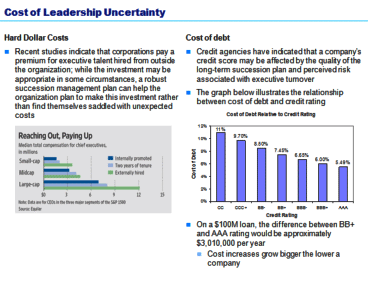
Recent Research: Investors Identify Their 7 Top Concerns Relative to Succession Planning
A recent study conducted by Integral Advisors, LLC and Board Advisor, LLC suggests that analysts, investment banks, rating agencies and others increasingly downgrade companies that fail to give succession planning their full attention at both board and management levels. This finding is based on in-depth interviews with key investment analysts, pension advisors, investment banks, private equity investors, ratings agencies and several equity-related organizations conducted between December 2009 and January 2010. (Figure 2) The study was prompted by the Securities and Exchange Commission’s change in position regarding shareholder proposals on CEO succession planning last October amidst widespread criticism of Bank of America.
When asked what they judge to be the main board responsibilities, interviewees ranked succession planning among the top three concerns, right behind monitoring oversight and strategic business planning. Other consistent themes running through the interviews included the following.
Figure 2
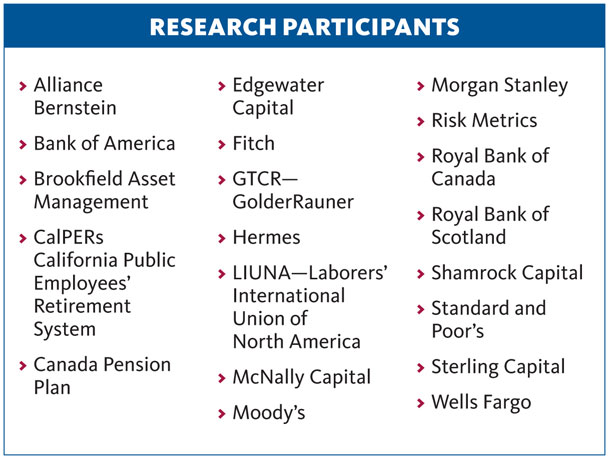
Other Commonalities: Top Management, Active Boards, Bench Strength
Many of the interviewed investors stated that their number one goal is to invest in companies with “top quality management”. Top quality management was usually defined as having a strong, demonstrable track record (preferably within the same industry) and being capable of adapting to changing business and economic conditions. A company’s top executives may currently have an adequate skill set, but as companies change business strategies, new experience and attributes may be warranted (i.e. from incremental/transactional change to transformational change or operational effectiveness/cost cutting to growth and innovation) they must continuously develop leaders who fit the firm’s evolving business model—with an eye to the future. Without exception, all investor groups expressed a strong preference for internal successors.
To this end, investors view active board involvement in SP as a huge plus. They want boards to be able to describe their succession planning process in detail and cite examples demonstrating that their oversight added value. They also prize board members who visit managers one to two levels below the CEO in their own milieu. In addition, high turnover of people who report directly to the CEO is a major red flag for analysts because it could portend other problems.
Pension Funds Perspectives
Of all the investor groups we interviewed, managers of pension funds are the most rigorous regarding assessment of SP. Because they are long-term investors who hold company stock into perpetuity, succession planning mechanisms are always essential. Pension funds often have guidelines in place that are consulted when considering companies to add to their portfolios, and rank succession as one of the most important board responsibilities. These investors are interested in companies where the board of directors a) review SP annually and place SP on the agenda frequently, b) have well developed criteria for the CEO and C-level positions that reflects the overall business strategy, c) apply formal assessment process to evaluate candidates, d) maintain a development process for internal candidates, and e) formulate a non-emergency succession plan that begins 3 years before an expected transition as well as an emergency succession planning procedure.
Private Equity Perspectives
Some investors, primarily private equity firms and analysts, apply little rigor to management evaluation– relying on judgment calls and conversations with the board and management. But several in this category mentioned that this attitude is changing, due to longer holding periods and fewer exit options. In fact, some PE firms have developed their own sets of desired management capabilities and are using psychological assessment tools as well as executive competency libraries.
Most investors review proxy’s and websites for obtaining information about management practice, but many rely heavily on conversations with board and management. Several analysts indicate that they rely on “feel” gleaned from extensive conversation with executives. Significantly, in doing so they all try to determine management’s comfort with change: — often digging into the backgrounds of those next in line. For those respondents who expressed a preference for “hard” or quantitative metrics, moreover, the metrics cited most frequently were the number of ready successors for key roles and the rate of turnover in key roles. A few financial institutions project the potential impact of management change by measuring CEO tenure against TSR for that period of time. Among the analysts who mentioned that succession planning is of key importance, about half reported that there is no specific metric used in measuring bench strength.
The View from the Ratings Agencies
Moody’s believes that the robustness of an organization’s succession planning provides insight into the overall quality of governance. In their analysis of Unexpected CEO Departures, Moody’s articulates a board’s succession planning responsibilities, saying that every board should a) have an emergency CEO succession plan in place, and b) ensure effective management development and CEO succession planning. Moody’s also considers the impact of succession planning across multiple industries, to varying degrees. For instance, in determining their Bank Financial Strength Ratings (“BSFR”), Moody’s reviews a bank or financial institution’s “Key Man Risk” (Figure 3). Key Man Risk is defined as the degree to which a bank’s key business decisions are dependent upon a single executive or group of executives. It is therefore an evaluation of the organization’s exposure as a result of these dependencies. Moody’s feels that in the event of key departures, banks with high Key Man Risk will face significant challenges, regardless of established succession plan processes. As part of their review of Governance and Management, Moody’s also considers succession planning for not-for-profit hospitals, health systems and family-controlled organizations. Similarly, the RiskMetrics Group considers succession planning when evaluating the effectiveness of an organization’s overall governance system. Although RiskMetrics does not disclose its weighting of each variable, the institution has stated that “succession planning is one of the most relevant elements in determining a company’s score”.
Figure 3
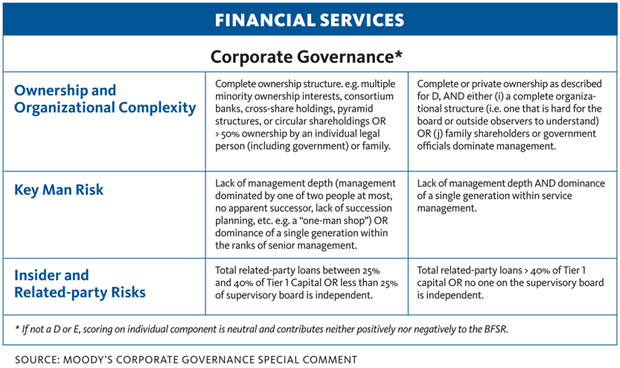
Executing Strategy through Succession Planning: A Case in Brief
In light of these strong indications that investors perceive succession planning as an important element of business policy and risk, it will be useful to consider a case study of how succession planning procedures can be directed toward strategic aims. Recently, the board of a $15 billion publicly traded heavy manufacturing company raised concerns about who might succeed their current CEO, if need be. Most of the board members did not believe there was a strong internal successor. The board expressed this concern to the CEO, who had previously provided them with a list of persons he considered qualified to succeed him. The board was not fully in agreement with his choice of potential successors. They felt that not enough focus was being placed on CEO succession and requested more information about qualified future leaders and development processes in place. To its credit, this board–unlike too many others–wanted more than just an emergency plan for replacing the CEO alone. Their goal was to establish a constitutive policy of succession planning designed to identify successors for the most important positions, build a strong management pipeline, reduce shareholder risk and stay ahead of public scrutiny and increasing investor activism.
At the board’s urging, the CEO retained this author to conduct a review of the current state of succession using the findings from the above mentioned investor research including an appraisal of management depth and an assessment of internal management development processes. Interviews with board members, management and analysis of internal data revealed a host of interesting findings. The most surprising discovery from management was a lack of consensus on the company’s business strategy. Many stated that the company’s present goal was to ride out the recession. Others were “hunkering down” and waiting for things to return to normal. Another alarming fact about this company was that 100 percent of its officers were set to retire within five to six years, and there were few strong candidates ready now or being developed to fill those positions.
Tangible Measures: A Succession Risk Index
To help the CEO and the board recognize the hazards of not having a more robust policy of succession planning, a Succession Risk Index was used by the board. (figure 4). Identifying and measuring factors across seven key categories determined by the investor research, this index helped to quickly pinpoint risk exposure and create a baseline against which to measure improvement. The seven categories of measurement included the rigor of succession planning processes, senior team tenure, key executive exposures, bench depth, board engagement, management development and cultural factors. Tangible examples of this company’s succession planning were compared to the index. Bench Depth revealed a lack of successors in the top three levels (i.e., 1 – 2 ready now replacements) (figure 5), 100% of Officers are retirement eligible within 5 years (figure 6), almost 50% of the second level of managers are retirement eligible in 5 years, lack of ready replacement for CEO, lack of a strong pool of high potentials (i.e., third level). Succession Planning Process revealed inconsistent succession reviews were held, performance data lacked rigor and was not based on current leadership competencies, there was no consensus among the executives regarding the succession planning process and no emergency plan.
Figure 4
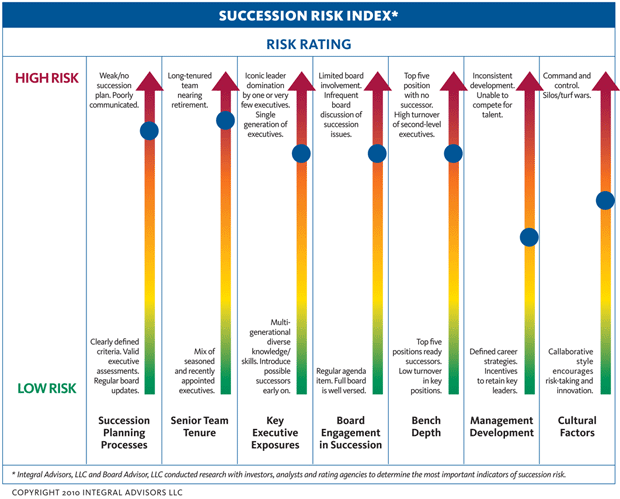
Figure 5
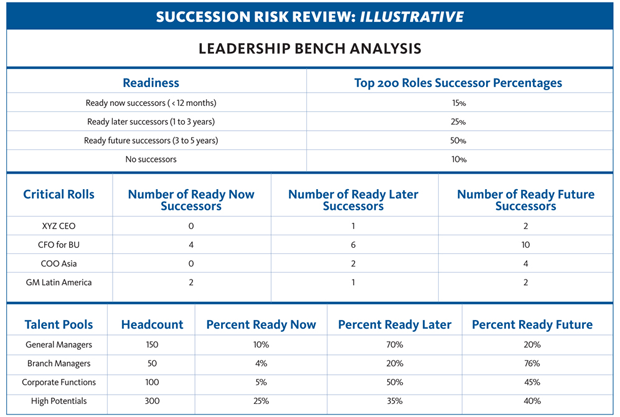
Figure 6
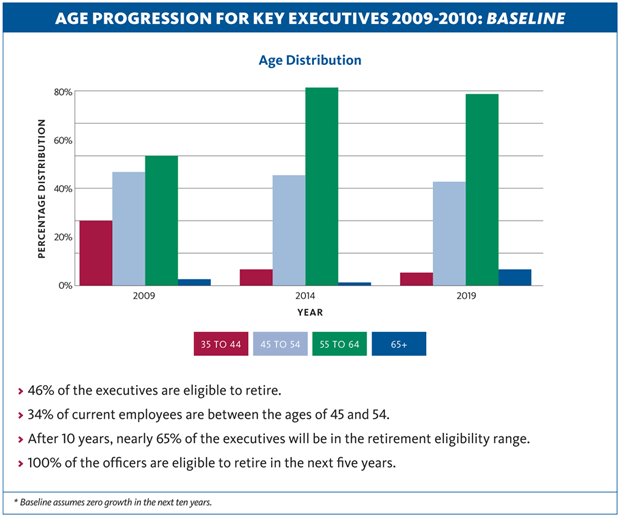
The discovery process also yielded other qualitative, but no less essential and insightful information. It came to light that the company had a command and control culture and insular focus which was inconsistent with its stated desire to become more innovative and growth oriented. Interviews consistently revealed that employees were reluctant to take risks because they feared making mistakes for which they might be penalized.
As a result of this discovery and analysis process, members of the board came to understand that they were at risk due to inadequate succession planning, lacked the information necessary to make crucial decisions, urgently needed to zero in on a strategic direction of the company and develop new leadership capable of executing it. Once the discovery process was completed, the board received the following recommendations and the CEO swiftly took action to implement them:
Other measures were adopted included developing an emergency succession process, changing the name of the compensation committee,adding language about SP to the proxy and the committee charter.
The board expressed that the process was highly informative, prompted important dialogue, and led to significant changes to management succession and governance.
Proactively shaping the company’s leadership
The company featured in the case study above proactively lowered their enterprise risk as well as the potential for damage by downgrades from outside analysts and rating agencies. The board and the CEO are working collaboratively to proactively ensure alignment of current and emerging business requirements and executive talent. This board in partnership with the CEO is literally shaping the future of the firm by ensuring the right leadership and leaders are in place. It is quite clear that more intensive investor focus, as identified in the study, is not a passing fad. Just ask the boards of Bank of America, Apple, General Motors, AIG, Whole Foods and lately, Hewlett-Packard.
For over 25 years, Bruce Sherman has served as an advisor to boards, CEOs and senior business leaders on executive talent strategy, succession planning, executive assessment/performance appraisal and coaching—most recently leading practices at Towers Perrin and Hewitt. Integral Advisors, LLC, is an independent board advisory specializing in unplanned and planned CEO succession and executive talent strategies.
Chief Executive Group exists to improve the performance of U.S. CEOs, senior executives and public-company directors, helping you grow your companies, build your communities and strengthen society. Learn more at chiefexecutivegroup.com.
0

1:00 - 5:00 pm
Over 70% of Executives Surveyed Agree: Many Strategic Planning Efforts Lack Systematic Approach Tips for Enhancing Your Strategic Planning Process
Executives expressed frustration with their current strategic planning process. Issues include:
Steve Rutan and Denise Harrison have put together an afternoon workshop that will provide the tools you need to address these concerns. They have worked with hundreds of executives to develop a systematic approach that will enable your team to make better decisions during strategic planning. Steve and Denise will walk you through exercises for prioritizing your lists and steps that will reset and reinvigorate your process. This will be a hands-on workshop that will enable you to think about your business as you use the tools that are being presented. If you are ready for a Strategic Planning tune-up, select this workshop in your registration form. The additional fee of $695 will be added to your total.

2:00 - 5:00 pm
Female leaders face the same issues all leaders do, but they often face additional challenges too. In this peer session, we will facilitate a discussion of best practices and how to overcome common barriers to help women leaders be more effective within and outside their organizations.
Limited space available.

10:30 - 5:00 pm
General’s Retreat at Hermitage Golf Course
Sponsored by UBS
General’s Retreat, built in 1986 with architect Gary Roger Baird, has been voted the “Best Golf Course in Nashville” and is a “must play” when visiting the Nashville, Tennessee area. With the beautiful setting along the Cumberland River, golfers of all capabilities will thoroughly enjoy the golf, scenery and hospitality.
The golf outing fee includes transportation to and from the hotel, greens/cart fees, use of practice facilities, and boxed lunch. The bus will leave the hotel at 10:30 am for a noon shotgun start and return to the hotel after the cocktail reception following the completion of the round.